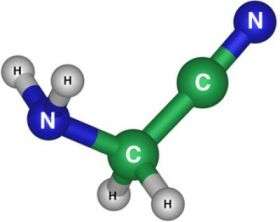New organic molecule in space

The "Large Molecule Heimat" is a very dense, hot gas clump within the star forming region Sagittarius B2. In this source of only 0,3 light-year diameter, which is heated by a deeply embedded newly formed star, most of the interstellar molecules known to date have been found, including the most complex ones such as ethyl alcohol, formaldehyde, formic acid, acetic acid, glycol aldehyde (a basic sugar), and ethylene glycol.
Starting from 1965, more than 140 molecular species have been detected in space, in interstellar clouds as well as in circumstellar envelopes. A large fraction of these molecules is organic or carbon-based. A lot of attention is given to the quest for so-called "bio"-molecules, especially interstellar amino acids. Amino acids, the building blocks of proteins and therefore key ingredients for the origin of life, have been found in meteorites on Earth, but not yet in interstellar space.
The simplest amino acid, glycine (NH2CH2COOH), has long been searched for in the interstellar medium but has so far not been unambiguously detected. Since the search for glycine has turned out to be extremely difficult, a chemically related molecule was searched for, amino acetonitrile (NH2CH2CN), probably a direct precursor of glycine.
The scientists from the Max Planck Institute for Radioastronomy in Bonn selected the "Large Molecule Heimat", as the source has been named by experts, and investigated a dense forest of 3700 spectral lines from complex molecules with the IRAM 30-metre telescope in Spain. Atoms and molecules emit light at very specific frequencies, which appear as characteristic lines in the radiation spectrum. By analyzing these spectral lines, astronomers can determine the chemical composition of cosmic clouds. The more complex a molecule is, the more possibilities it has to radiate its internal energy. This is the reason why complex molecules emit many spectral lines, which are very weak and therefore difficult to identify in the "line jungle".
"Still, we were finally able to assign 51 very weak lines to the molecule amino acetonitrile" says Arnaud Belloche, scientist at the Max Planck institute and first author of the research paper. This result was confirmed at 10 times higher spatial resolution with two radio telescope arrays, the IRAM Plateau de Bure interferometer in France and the Australia Telescope Compact Array. These observations showed that all the candidate lines were emitted from the same position in the "Large Molecule Heimat", "a strong proof of the reliability of our identification".
"Finding amino acetonitrile has greatly extended our insight into the chemistry of dense, hot star-forming regions. I am sure we will be able to identify in the future many new, even more complex organic molecules in the interstellar gas. We already have several candidates!" says Karl Menten, director at the Max Planck Institute for Radioastronomy and head of the "Millimeter and Submillimeter Astronomy" research group.
Citation: Detection of amino acetonitrile in Sgr B2(N), A. Belloche, K. M. Menten, C. Comito, H. S. P. Muller, P. Schilke, J. Ott, S. Thorwirth, C. Hieret, Astronomy & Astrophysics (in press), [DOI 10.1051/0004-6361: 20079203]
Source: Max-Planck-Gesellschaft





















